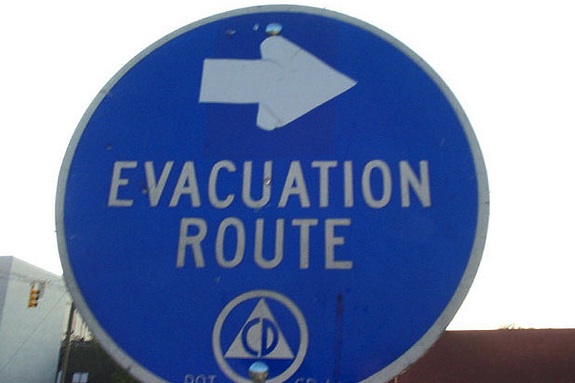To Evacuate or Not To Evacuate?
Issuing mandatory evacuation orders is an effective means of encouraging residents to leave unsafe zones, but fear mongering is more iffy

Photo: taberandrew
Evacuating from any potential natural disaster is, admittedly, a pain. Do you pack treasured family photographs alongside the canned beans and flashlights, taking up precious space? How will the cat handle the stress of relocation, and how will the litter box make the hotel smell? Do you head to nearby high ground, or schedule an impromptu vacation a bit further out?
While all of these details crowd any evacuation plan, the decision whether or not to evacuate in the first place creates a divider between residents. In the case of hurricanes, coastal residents often chose to stay put—but why?
Writing about Tropical Storm Isaac last August, Mother Nature Network analyzes this decision process:
Research shows that many are reluctant to leave in the face of a Category 1 or Category 2 hurricane.
“People say, ‘Oh Category 1, no big deal.’ But any hurricane is a big deal, and people need to recognize that and take precautions,” said Susan Cutter, director of the Hazards and Vulnerability Research Institute at the University of South Carolina
A survey Cutter and her team conducted in South Carolina revealed that 61 percent of coastal residents—including those residing in designated storm surge areas—said they probably would stay put in the face of a Category 1 or 2 storm, so long as an evacuation order had not been issued.
The poll found that mandatory evacuation orders were more effective, with 75 percent of residents saying they would leave if such a mandate was issued for a Category 1 or Category 2 hurricane. But just 50 percent said they would go if the evacuation was recommended instead of mandatory, the survey found.
If residents were told they couldn’t return home for over a week, however, willingness to evacuate dropped to 45 percent, even in the face of a mandatory warning. And if they had to leave their pets behind, nearly all the respondents said they would stay and face the storm.
But there’s a fine line between safety and fear mongering. For East Coasters weathering out Hurricane Sandy this week, many of the evacuation encouragement strategies seem to be based entirely on inducing terror, perhaps in an attempt to break down the region’s stereotypical cynicism.
Slate directs readers to their favorite over-hyped Hurricane Sandy warnings:
IF YOU ARE RELUCTANT, THINK ABOUT YOUR LOVED ONES, THINK ABOUT THE EMERGENCY RESPONDERS WHO WILL BE UNABLE TO REACH YOU WHEN YOU MAKE THE PANICKED PHONE CALL TO BE RESCUED, THINK ABOUT THE RESCUE/RECOVERY TEAMS WHO WILL RESCUE YOU IF YOU ARE INJURED OR RECOVER YOUR REMAINS IF YOU DO NOT SURVIVE. (National Weather Service)
History is being written as an extreme weather event continues to unfold, one which will occupy a place in the annals of weather history as one of the most extraordinary to have affected the United States. … This is an extraordinary situation, and I am not prone to hyperbole. (Weather Channel meteorologist Stu Ostro)
Hurricane Sandy is the “most catastrophic event that we have faced and been able to plan for in any of our lifetimes.” (Connecticut Gov. Dan Malloy)
Ever written your own prayer? Now’s the time. Get your thoughts together on Hurricane Sandy. (Huffington Post’s religion Twitter feed)
If the situation is really as bad as these sources describe, we might all be better off just listening to The Onion: ”Tell your children firmly and clearly, ‘I’m so sorry that we’re all going to die.’”
More from Smithsonian.com:
Top 10 Most Damaging US Hurricanes
Can We Link Hurricane Sandy to Climate Change?
/https://tf-cmsv2-smithsonianmag-media.s3.amazonaws.com/accounts/headshot/Rachel-Nuwer-240.jpg)
/https://tf-cmsv2-smithsonianmag-media.s3.amazonaws.com/accounts/headshot/Rachel-Nuwer-240.jpg)